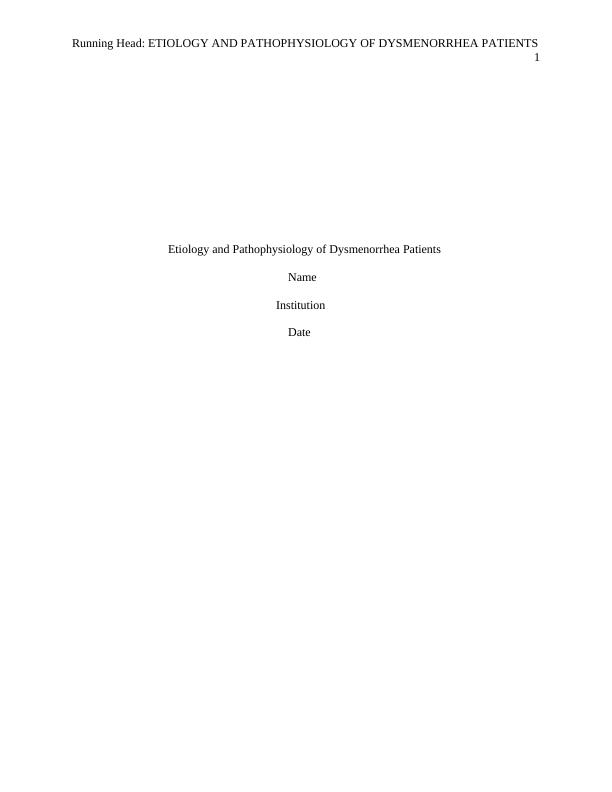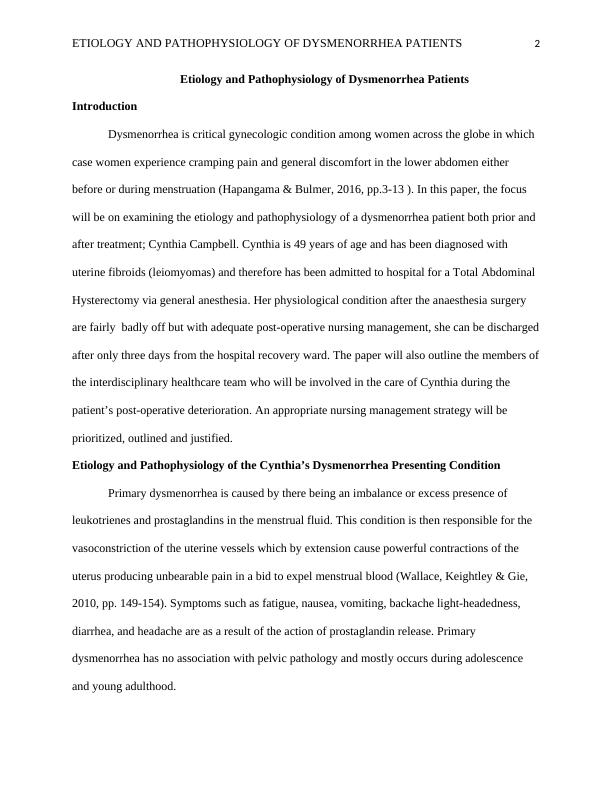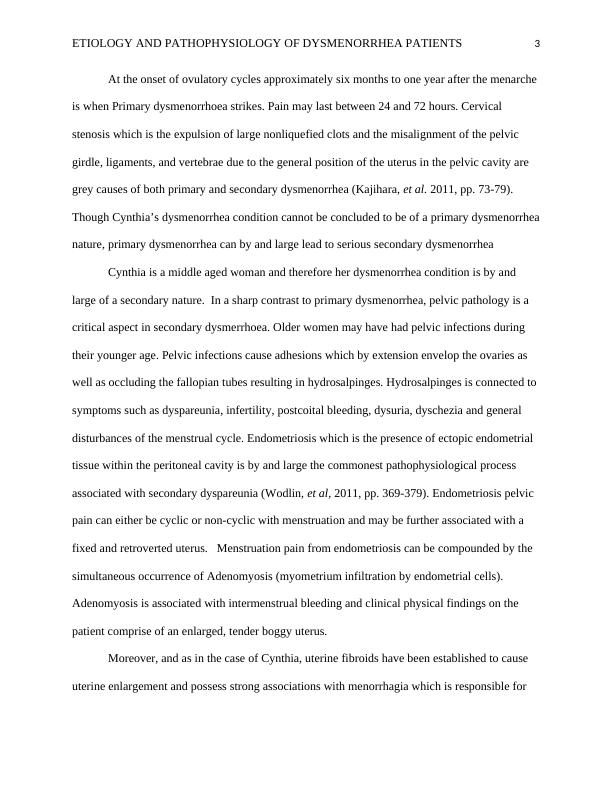Etiology and Pathophysiology of Dysmenorrhea Patients
Added on 2023-06-09
11 Pages2664 Words399 Views
Running Head: ETIOLOGY AND PATHOPHYSIOLOGY OF DYSMENORRHEA PATIENTS
1
Etiology and Pathophysiology of Dysmenorrhea Patients
Name
Institution
Date
1
Etiology and Pathophysiology of Dysmenorrhea Patients
Name
Institution
Date

ETIOLOGY AND PATHOPHYSIOLOGY OF DYSMENORRHEA PATIENTS 2
Etiology and Pathophysiology of Dysmenorrhea Patients
Introduction
Dysmenorrhea is critical gynecologic condition among women across the globe in which
case women experience cramping pain and general discomfort in the lower abdomen either
before or during menstruation (Hapangama & Bulmer, 2016, pp.3-13 ). In this paper, the focus
will be on examining the etiology and pathophysiology of a dysmenorrhea patient both prior and
after treatment; Cynthia Campbell. Cynthia is 49 years of age and has been diagnosed with
uterine fibroids (leiomyomas) and therefore has been admitted to hospital for a Total Abdominal
Hysterectomy via general anesthesia. Her physiological condition after the anaesthesia surgery
are fairly badly off but with adequate post-operative nursing management, she can be discharged
after only three days from the hospital recovery ward. The paper will also outline the members of
the interdisciplinary healthcare team who will be involved in the care of Cynthia during the
patient’s post-operative deterioration. An appropriate nursing management strategy will be
prioritized, outlined and justified.
Etiology and Pathophysiology of the Cynthia’s Dysmenorrhea Presenting Condition
Primary dysmenorrhea is caused by there being an imbalance or excess presence of
leukotrienes and prostaglandins in the menstrual fluid. This condition is then responsible for the
vasoconstriction of the uterine vessels which by extension cause powerful contractions of the
uterus producing unbearable pain in a bid to expel menstrual blood (Wallace, Keightley & Gie,
2010, pp. 149-154). Symptoms such as fatigue, nausea, vomiting, backache light-headedness,
diarrhea, and headache are as a result of the action of prostaglandin release. Primary
dysmenorrhea has no association with pelvic pathology and mostly occurs during adolescence
and young adulthood.
Etiology and Pathophysiology of Dysmenorrhea Patients
Introduction
Dysmenorrhea is critical gynecologic condition among women across the globe in which
case women experience cramping pain and general discomfort in the lower abdomen either
before or during menstruation (Hapangama & Bulmer, 2016, pp.3-13 ). In this paper, the focus
will be on examining the etiology and pathophysiology of a dysmenorrhea patient both prior and
after treatment; Cynthia Campbell. Cynthia is 49 years of age and has been diagnosed with
uterine fibroids (leiomyomas) and therefore has been admitted to hospital for a Total Abdominal
Hysterectomy via general anesthesia. Her physiological condition after the anaesthesia surgery
are fairly badly off but with adequate post-operative nursing management, she can be discharged
after only three days from the hospital recovery ward. The paper will also outline the members of
the interdisciplinary healthcare team who will be involved in the care of Cynthia during the
patient’s post-operative deterioration. An appropriate nursing management strategy will be
prioritized, outlined and justified.
Etiology and Pathophysiology of the Cynthia’s Dysmenorrhea Presenting Condition
Primary dysmenorrhea is caused by there being an imbalance or excess presence of
leukotrienes and prostaglandins in the menstrual fluid. This condition is then responsible for the
vasoconstriction of the uterine vessels which by extension cause powerful contractions of the
uterus producing unbearable pain in a bid to expel menstrual blood (Wallace, Keightley & Gie,
2010, pp. 149-154). Symptoms such as fatigue, nausea, vomiting, backache light-headedness,
diarrhea, and headache are as a result of the action of prostaglandin release. Primary
dysmenorrhea has no association with pelvic pathology and mostly occurs during adolescence
and young adulthood.

ETIOLOGY AND PATHOPHYSIOLOGY OF DYSMENORRHEA PATIENTS 3
At the onset of ovulatory cycles approximately six months to one year after the menarche
is when Primary dysmenorrhoea strikes. Pain may last between 24 and 72 hours. Cervical
stenosis which is the expulsion of large nonliquefied clots and the misalignment of the pelvic
girdle, ligaments, and vertebrae due to the general position of the uterus in the pelvic cavity are
grey causes of both primary and secondary dysmenorrhea (Kajihara, et al. 2011, pp. 73-79).
Though Cynthia’s dysmenorrhea condition cannot be concluded to be of a primary dysmenorrhea
nature, primary dysmenorrhea can by and large lead to serious secondary dysmenorrhea
Cynthia is a middle aged woman and therefore her dysmenorrhea condition is by and
large of a secondary nature. In a sharp contrast to primary dysmenorrhea, pelvic pathology is a
critical aspect in secondary dysmerrhoea. Older women may have had pelvic infections during
their younger age. Pelvic infections cause adhesions which by extension envelop the ovaries as
well as occluding the fallopian tubes resulting in hydrosalpinges. Hydrosalpinges is connected to
symptoms such as dyspareunia, infertility, postcoital bleeding, dysuria, dyschezia and general
disturbances of the menstrual cycle. Endometriosis which is the presence of ectopic endometrial
tissue within the peritoneal cavity is by and large the commonest pathophysiological process
associated with secondary dyspareunia (Wodlin, et al, 2011, pp. 369-379). Endometriosis pelvic
pain can either be cyclic or non-cyclic with menstruation and may be further associated with a
fixed and retroverted uterus. Menstruation pain from endometriosis can be compounded by the
simultaneous occurrence of Adenomyosis (myometrium infiltration by endometrial cells).
Adenomyosis is associated with intermenstrual bleeding and clinical physical findings on the
patient comprise of an enlarged, tender boggy uterus.
Moreover, and as in the case of Cynthia, uterine fibroids have been established to cause
uterine enlargement and possess strong associations with menorrhagia which is responsible for
At the onset of ovulatory cycles approximately six months to one year after the menarche
is when Primary dysmenorrhoea strikes. Pain may last between 24 and 72 hours. Cervical
stenosis which is the expulsion of large nonliquefied clots and the misalignment of the pelvic
girdle, ligaments, and vertebrae due to the general position of the uterus in the pelvic cavity are
grey causes of both primary and secondary dysmenorrhea (Kajihara, et al. 2011, pp. 73-79).
Though Cynthia’s dysmenorrhea condition cannot be concluded to be of a primary dysmenorrhea
nature, primary dysmenorrhea can by and large lead to serious secondary dysmenorrhea
Cynthia is a middle aged woman and therefore her dysmenorrhea condition is by and
large of a secondary nature. In a sharp contrast to primary dysmenorrhea, pelvic pathology is a
critical aspect in secondary dysmerrhoea. Older women may have had pelvic infections during
their younger age. Pelvic infections cause adhesions which by extension envelop the ovaries as
well as occluding the fallopian tubes resulting in hydrosalpinges. Hydrosalpinges is connected to
symptoms such as dyspareunia, infertility, postcoital bleeding, dysuria, dyschezia and general
disturbances of the menstrual cycle. Endometriosis which is the presence of ectopic endometrial
tissue within the peritoneal cavity is by and large the commonest pathophysiological process
associated with secondary dyspareunia (Wodlin, et al, 2011, pp. 369-379). Endometriosis pelvic
pain can either be cyclic or non-cyclic with menstruation and may be further associated with a
fixed and retroverted uterus. Menstruation pain from endometriosis can be compounded by the
simultaneous occurrence of Adenomyosis (myometrium infiltration by endometrial cells).
Adenomyosis is associated with intermenstrual bleeding and clinical physical findings on the
patient comprise of an enlarged, tender boggy uterus.
Moreover, and as in the case of Cynthia, uterine fibroids have been established to cause
uterine enlargement and possess strong associations with menorrhagia which is responsible for

ETIOLOGY AND PATHOPHYSIOLOGY OF DYSMENORRHEA PATIENTS 4
causing dysmenorrhea (Edlund, 2009, pp.12-33). Endometrium structural pathology like polyps
is also responsible for cycle disturbances which then lead to pain during menstruation. It is also
possible to contract dysmenorrhea through various congenital uterine anomalies such as
unicornuate uterus with a noncommunicating rudimentary uterine cornu as well as cervical
stenosis. The pelvic inflammatory disease in which case patients are observed to have cervical
motion tenderness, adnexal tenderness, and uterine tenderness may also be a big time cause of
secondary dysmenorrhea.
Cynthia has also been diagnosed to possess a mild history of depression possibly due to
loneliness fallowing her husband’s death and children away. Psychosocial factors such as
depression are potential conditions for the worsening of the chronic pelvic pain. Like in primary
dysmenorrhea, secondary dysmenorrhea is characterized by lower abdomen ache, depression,
headache, and fatigue. This may begin way before ovulation and extend several days to the next
menses.
Underlying Pathophysiology of the Cynthia’s Post-Operative Deterioration
Like what is expected of a Total Abdominal Hysterectomy and more so in the case of a
general anaesthesia, Cynthia is supposed to stay in the ward for at least three days so that
healthcare practitioners can monitor her for any discomfort, pain, and infections (Reeve &
Boden, 2016). Cynthia’s general physiological functions are by and large badly off from the
norm but they can significantly be improved causing no need for panic. Her respiratory rate of 30
breaths per minute is way higher than what is expected of a normal adult respiratory rate of 12 to
16 breaths per minute.
Her blood pressure of 90/50mmHg is lower than the normal 120/80mmHg and therefore
it needs to improve. Her pulse rate of 130bpm is way high as such a rate is for children between
causing dysmenorrhea (Edlund, 2009, pp.12-33). Endometrium structural pathology like polyps
is also responsible for cycle disturbances which then lead to pain during menstruation. It is also
possible to contract dysmenorrhea through various congenital uterine anomalies such as
unicornuate uterus with a noncommunicating rudimentary uterine cornu as well as cervical
stenosis. The pelvic inflammatory disease in which case patients are observed to have cervical
motion tenderness, adnexal tenderness, and uterine tenderness may also be a big time cause of
secondary dysmenorrhea.
Cynthia has also been diagnosed to possess a mild history of depression possibly due to
loneliness fallowing her husband’s death and children away. Psychosocial factors such as
depression are potential conditions for the worsening of the chronic pelvic pain. Like in primary
dysmenorrhea, secondary dysmenorrhea is characterized by lower abdomen ache, depression,
headache, and fatigue. This may begin way before ovulation and extend several days to the next
menses.
Underlying Pathophysiology of the Cynthia’s Post-Operative Deterioration
Like what is expected of a Total Abdominal Hysterectomy and more so in the case of a
general anaesthesia, Cynthia is supposed to stay in the ward for at least three days so that
healthcare practitioners can monitor her for any discomfort, pain, and infections (Reeve &
Boden, 2016). Cynthia’s general physiological functions are by and large badly off from the
norm but they can significantly be improved causing no need for panic. Her respiratory rate of 30
breaths per minute is way higher than what is expected of a normal adult respiratory rate of 12 to
16 breaths per minute.
Her blood pressure of 90/50mmHg is lower than the normal 120/80mmHg and therefore
it needs to improve. Her pulse rate of 130bpm is way high as such a rate is for children between

End of preview
Want to access all the pages? Upload your documents or become a member.
Related Documents
Acute Care Nursing: Case Study of Cynthia Joneslg...
|10
|2375
|220
Uterine Fibroids: Etiology, Pathophysiology, and Patient Carelg...
|11
|2966
|113
Fibroids – Cynthia’s Case Studylg...
|11
|2494
|142
Post-Operative Care: A Case Study of a Patient with Uterine Fibroidslg...
|11
|2965
|89
Diagnostic features present in the patient arelg...
|12
|2631
|57
NRSG258 - Acute Care - Uterine Fibroid Control & Managementlg...
|10
|2730
|14
